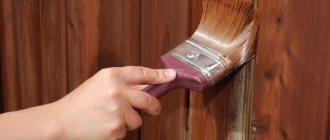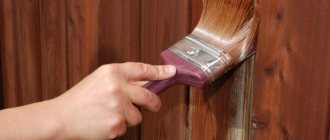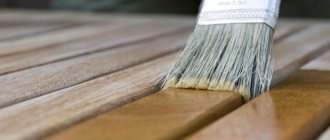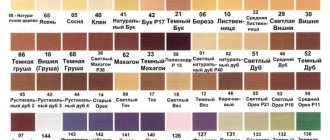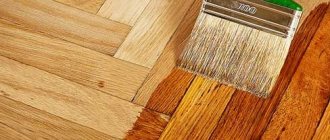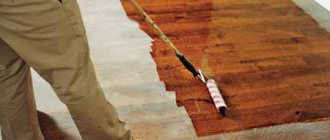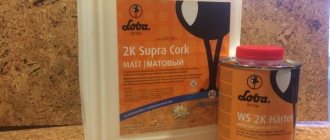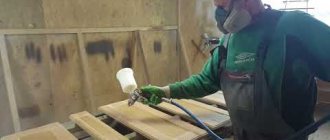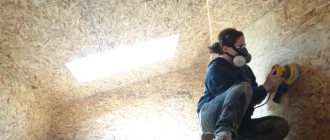Ceramic granite is a strong material that is not afraid of adverse effects. Nowadays, porcelain tiles are used for finishing floors, this is understandable, because such a material is distinguished by high strength indicators and an excellent degree of wear resistance. But in order to preserve the beautiful appearance of the floor covering and increase its service life, good care .
The material itself is not afraid of dirt, but the seams between the tiles are susceptible to the action of an aggressive environment, quickly become dirty, and in case of strong mechanical influence, destruction occurs. Due to this, such floor coverings should be regularly monitored and well
using a special cleaning agent.
Impregnations for the care and protection of ceramic granite
Master class on creating the “wet stone” effect
Walking along the city streets in rainy weather, each of you probably noticed how the facades of natural stone buildings, wetted by raindrops, are transformed. When soaked in water, they become brighter and more picturesque than they really are, and their reliefs and texture patterns created by nature begin to appear in a completely different mood.
But, alas, on soft types of natural stone, such as limestone, sandstone, travertine and marble, the atmospheric phenomenon described above does not “affect” at all, but, on the contrary, has a detrimental effect. After all, the listed types of natural stones, saturated with moisture and saturated with salts, begin to gradually become covered with microcracks and collapse.
However, today a highly effective method has been invented that allows you to obtain the “wet stone” effect by fixing it for a long period of time. This method consists of using any product, the main ingredient in the creation of which is fat.
Today's markets offer a wide range of different chemical impregnations that make it possible to achieve the effect of a wet surface on natural stone. Since these compounds differ from each other in their component composition, the results of their action also differ.
While some emulsions create the thinnest “wet” film on the outer surface of the rock, others, penetrating deep into the material, clog most of its pores and polymerize them, forming a “raw” effect. The second option is the most preferable, and this is what we will recommend to you today, since, unlike the first, it does not “evaporate” over time with regular care of stone products.
A product for imparting a “wet effect” to various types of natural stone (limestone, “Tree Bark” slate, lemezite, sandstone, sawn granite, etc.) is called “AGER”. This coating of a fluid consistency emphasizes the natural color and structural structure of the stone product and at the same time has a transparent or opal tint.
The required amount of AGER liquid is determined based on the type, porosity and size of the stone “body”, however, according to the instructions for use, for processing 25-30 sq.
Types of decorative and protective coatings
Modern decorative and protective compounds intended for coating stone penetrate into microcracks in natural materials, filling them, preventing moisture from penetrating inside, and repelling water. The choice of such a product primarily depends on the functional characteristics of the stone or tile.
Wet stone effect varnish
There are a huge number of impregnations that differ in their chemical compositions and physical properties. These substances are very popular in the construction industry. For decorative finishing of natural stone, varnish is used. A specific protective film is formed on the surface of the mineral composition.
The surface of a natural material treated in this way acquires a distinct color saturation, and moisture does not get into the microcracks of the surface. Saturation can be achieved through simple finishing procedures, simply applying the varnish to the surface with a paint brush.
A varnish with a “wet stone” effect must be chosen correctly, taking into account the operational characteristics of the stone. Otherwise, you may not get a high-quality and long-term effect. Features of choosing a varnish to create a wet effect:
For exterior work, special varnishes with enhanced functionality are used. The product must withstand temperature changes, increased mechanical stress, precipitation and ultraviolet rays as efficiently as possible. Using such means you can treat the surface of paving slabs and a façade lined with brick.
Finishing stone indoors requires minimal protection. The main thing is that the varnish can withstand the microclimatic conditions of the room. This composition is suitable for tiles in the bathroom or natural stone, decorative columns in the corridor, hallway.
Acrylic varnish has universal properties. If acrylic is water-based, then it is better to use it indoors, on a surface with minimal mechanical impact. Solvent-based acrylic varnishes are suitable for external finishing work, as they are characterized by increased toxicity and durability.
It is not advisable to treat sidewalk surfaces with varnish. Varnish is best used for painting facades, columns, and finishing elements of a building. Otherwise, you will have to frequently restore the surface.
In the video: using an organic-based wet-effect varnish.
Impregnation with high mechanical load
For paving slabs or tiles that are laid indoors on the floor, special compounds are used. Most often this is an impregnation with a wet stone effect. It is not recommended to use conventional dyes - this can spoil the mineral complex of the product.
Features of impregnation for paving made of natural materials:
- simplifies the procedure for maintaining the base;
- increases the service life of the coating;
- seals seams and joints between tiles;
- impregnation is used as an anti-slip agent;
- does not expose the surface to mold and mildew;
- wet-action impregnation is not exposed to aggressive chemicals.
During the processing process, it is necessary to fulfill a lot of conditions in order not to damage the building material, to make it more durable and aesthetically attractive. Thus, paving slabs and indoor tiles must be of a special type, since not all surfaces can be impregnated or covered with this type of varnish.
In the video: water repellent for granite slabs EC-77 - wet effect and protection.
Description
Impregnation water repellent for stone looks like a liquid, which includes a mineral dye, a binding element. Compared with coloring agents, the impregnating agent not only imparts color, but strengthens the properties of the material.
It impregnates the stone base inside and binds to its structure, resulting in a change in shade, and the surface receives protection from moisture, wind, ultraviolet radiation and biological formations.
Impregnation for marble and natural stone and other types is distinguished by its ability to be used not only for facade work, but also to eliminate traces of corrosion and salts. What will be used as constituent substances depends on the type of product; as a result of processing, a transparent film is obtained on the stone.
When is impregnation necessary?
Many people forget to protect the surface and then reap the negative consequences. It is better to spend money once and carry out the treatment than to see after several years that the surface has lost its color and has become less presentable. Protective substances are needed in the following cases:
Use of stone both outside and inside the room. Both internally and externally the material is influenced in various ways. Outside, these are ultraviolet rays, temperature changes, precipitation and high humidity. Inside, the stone is exposed to moisture; solutions with a caustic composition or household chemicals may come into contact with it. There is water inside too. Therefore, stains may form on the surface of marble or other stone or the material may begin to deteriorate. Don't forget about mold, moss and mildew. As such organisms grow, they simply begin to destroy the structure of the stone, making it ugly and fragile. The stones contain salt. Under certain conditions, salt from the inside begins to come out. There it crystallizes and also negatively affects the stone, destroying it.
There is a wet effect impregnation for stone on sale, which not only protects the material, but creates a beautiful wet shine effect on the surface. The material becomes more rich and presentable.
These factors tell us that impregnation of the material is simply necessary if it is necessary to extend its service life, decorate it and make it reliable.
Characteristics
Impregnation can be used not only for its protective properties during external treatment; a large number of different options have been created that have different characteristics. These differences are achieved by including different constituent elements.
This is how the composition is applied to reduce the impact of friction on countertops, window sills and other objects. This is a good way to preserve the decorative properties of a product longer.
Impregnation for porcelain tiles with a wet stone effect protects and gives a brighter color to the stone. Some products are absorbed deeply into the material; as a result, external influences cannot penetrate further into the base and do not affect its structure.
The stone will be protected from sunlight, and the richness of the shade will remain for many years. Strength characteristics increase.
Latex impregnations are available for sale, which provide reliable protection for the material even in harsh operating conditions.
Impregnation for artificial stone can also be used. Selected for paving stones, limestone and other substrates. Varnish impregnations are considered universal and are applicable for various types of stone products.
Protecting natural stone from graffiti
Recently, graffiti has become widespread. Some works can even be called objects of art, but basically these attempts to express themselves look like hooligan antics. Most graffiti paints are very difficult to remove from the surface of stone. To achieve results, you have to try several means. To avoid these difficulties, it is better to protect the surface of natural stone from paint penetration in advance, using products marked “anti-graffiti”. Stone treated with this product does not absorb paint, and it can be easily washed off with water and household detergents.
Types of varnish for wet effect paving slabs, and which one is better?
Wet effect tile varnish gives the coating a rich color, emphasizing the texture of the material. For surface treatment, water-based and solvent-based acrylic varnishes are considered.
Water-based varnish is more often used for interior decoration because it is non-toxic and does not have emissions harmful to the body.
The main advantages of processing varnish with a wet effect
Caring for paving slabs is no less important than caring for floor coverings in the house, since timely treatment of paths solves problems such as:
- abrasion;
- wear resistance;
- moisture resistance;
- aesthetics.
A coating treated with varnish that has a “wet effect” property will last longer, receive an additional matte shine and will look wet in dry weather, which will give the design of the paths an unusual look. In addition, tiles with a wet effect will be safer to use due to their anti-slip properties and will retain the natural shade of the material longer.
Seam processing
The seams between the stone elements should be made as even as possible. To do this, use a tool such as a jointer, which allows you to make the seams almost identical. After installation, the seams are filled with a moisture-resistant solution using a wooden stick. Only smooth and correct seams can give a stone pattern a finished look. If the stone is laid in even tiles, then finishing the seams and highlighting them may not be necessary. This installation is considered seamless and the stones are simply joined tightly together.
In order not to damage the structure and color of the stone, metal brushes should not be used when caring for it.
How to use the protectant
The process itself is quite simple. It is similar to priming or painting a surface. Everyone can do all the work with their own hands. To do this, you need appropriate materials and tools, as well as step-by-step instructions and following the basic rules.
What will you need for the job? Application can be done in two ways: using a paint brush or a spray gun. It’s faster and more efficient to use a spray gun. With it, a large surface will be processed in a matter of minutes. However, not everyone can afford such equipment. Then a regular paint brush is used. Although it is harder and longer to work with it, the result will be good. So, the sequence is as follows:
Treatment of any surface must begin with its preparation. Marble, granite, plaster or other stone needs to be cleaned. Oil stains, tar, bitumen, salt, mold and debris are removed from the surface. To do this, special cleaning products are used. Depending on the type of substance used, the surface of the stone must be made dry or wet. For example, a silicone-based impregnation requires a wet surface to begin the reaction. Usually there are instructions on the impregnation that indicate the conditions under which the work must be performed. During use, chips and cracks may form on the stone. To make the surface ideal after treatment, all cracks and chips must be eliminated. Epoxy resin and sand-cement mortar are suitable for this purpose. If the cracks are small, they are sealed with a mixture of cement and sand. But for large cracks, professionals recommend using epoxy resin. Another important point: the impregnation must be suitable or compatible with the material being processed. This information can be seen on the packaging. To avoid damaging the material, it is recommended to perform a test application on an area that will not be noticeable. If no negative changes have occurred, you can begin full processing. The impregnation is used in the form in which you purchased it. It is prohibited to modify, dilute or change its structure. There is no need to pour it into another container either. Work with the container in which the impregnation was sold. Now everything is ready for application. Ideal working conditions: temperature about 11 degrees no less, humidity more than 67%. The composition is evenly applied to the surface in a thin layer. It is necessary to process the entire surface, without skipping any areas. When the surface of the stone is ready, you need to let it dry for 12–14 hours. It should not be exposed to moisture. The substance will acquire its true moisture-protective properties after 38 hours. But for 10 years it will protect the material from negative influences.
You also need to remember the safety rules during work.
It is important to do everything with gloves to protect the skin of your hands, as well as with glasses. If the composition gets on your skin, you need to quickly rinse the area with warm water.
In addition, when working indoors, it is important to ensure good ventilation.
Note! Remaining substances must not be stored. If the impregnation remains, it must be disposed of
Tips for using impregnation
The technician must wear rubber gloves and safety glasses while working. If the product gets on the skin, the area is thoroughly washed with water. After applying the product, residues are not allowed to be stored; they are disposed of. The best weather conditions are considered to be +11 degrees and humidity over 67%.
Treating the surface of the stone with impregnating agents helps improve its properties and extend its service life. The application process is simple, so you can do it yourself. When choosing a composition, the operating conditions and the type of stone base are taken into account.
How to provide comprehensive protection
Reliable comprehensive road protection before putting it into operation provides not only a kind of “protective film” that guarantees high functionality in the future. It is ideal to do some of the operations before laying the tile covering, since the protective impregnation of the blind area is best done at this time.
Treatment of any type of road or sidewalk surface is divided into the following stages:
Preliminary cleaning of existing contaminants. It is produced using special detergents, which allows you to completely wash off not only dirt, but also various chemical deposits from the tiled or sidewalk surface. The older the road, the more complex pre-cleaning may be required. Application of hydrophobic composition. This will create the effect of a transparent water-repellent film. Even a road surface wet from rain or snow in this case will be less susceptible to the destructive effects of moisture
This is especially important for roads operating in difficult climatic conditions. Subsequent painting with decorative compounds, for example, special varnish. Allows you to get a beautiful “wet stone” effect, highlighting the natural color
Often used for paving stones made from natural materials that have become dull over time.
The same technology is used to “revitalize” roads covered with natural or artificial paving stones. If any type of road surface is just planned, it must be treated with a special impregnation before laying, which increases the frost resistance of concrete. This will prevent further destruction in the future due to low temperatures and constant penetration of moisture.
Consumer Reviews
Users are satisfied with the performance of the impregnations. This is clear from their statements. Impregnations for stone: reviews.
Evgeniy: “When building a foundation, a lot of attention is paid to protecting the concrete from moisture. Waterproofing materials are used. I discovered special hydrophobic impregnations. I like it. I applied them to the concrete surface and used roofing felt. The defense is good."
Victor: “I made a wall from natural stone at my home. It looks just great. However, I know that she needs protection, since there are children at home who can either damage or ruin the appearance. Yes, and we have a sunny side, the sun is constantly influencing the wall. I found out that there are special protective impregnations. I used Olympus products. The impregnation for the stone turned out to be good. After 1 year of use, the wall looks like new.”
Mikhail: “I used impregnation with a wet effect. The result is truly impressive. Although some said that the result would not be visible. I liked it, the surface became more expressive and beautiful.”
Instructions for use
Impregnation or varnish is sold ready-made. If a more liquid composition is required, the substance can be diluted with a regular solvent. To perform painting, you should additionally purchase a paint brush. A roller will not work, as it will not allow the substance to penetrate into the small pores of the material.
To prevent the stones from being damaged during processing, it is worth carrying out the work in accordance with certain instructions:
- The surface to be treated must be free of debris and dust. You can sweep the area, but the best solution is a vacuum cleaner. Very dirty areas will need to be washed.
- Be sure to dry the brick, stone or tile base, since the varnish does not stick to wet stone, and subsequently does not dry.
- Several thin layers of the composition are applied at regular intervals. If the previous layer has not yet dried, then the next one cannot be applied.
- Brick and porous tiles sometimes require several additional layers of coating. They also need to be applied evenly.
- Let the treated tile stand for a while so that the coating is completely fixed, saturating all microcracks and chips. The required time for fixation is two weeks.
As a result of quality work, a rich color is obtained, and the coating segments become wet. Thanks to impregnation, the conditions for using coatings and decor made from natural materials are improved. The mineral composition of the stone and its properties are preserved, and geodesy is improved. Any person who does not have special skills and experience in repair work can cope with the application of the material.
Popular hydrophobic solutions
One of the widely used hydrophobic solutions is Tiprom M, which provides good protection of the material from moisture penetration and ice formation. This impregnation creates a “wet” effect for paving slabs, improving their appearance. By using this water repellent, you can avoid covering with a protective layer of waterproof varnish.
Wet effect: example.
Rain or snow, when using this solution, can fall on the path and the quality of the protective coating will not be affected. Do not treat in areas where water is actively draining and where puddles are constantly forming.
The same manufacturer produces a deep-penetrating hydrophobic impregnating solution specifically for wet areas - “Tiprom K LUX”. Possessing all the qualities of the previous water repellent, this impregnation penetrates into pores (to a depth of 20 mm) and can be used under any operating conditions of the road surface.
Among the imported developments of hydrophobic coatings for paving slabs, we can note: Ceresit CT10, Impregnat Dry and VOKA. All of them have good water-repellent qualities, but are much more expensive than domestic compounds, which limits their widespread use.
Ceresit CT10 is a water repellent based on organic silicone. Provides comprehensive protection of the sidewalk surface, has a “wet stone” effect, creates a durable protective film from the first coating, has antibacterial and biological protection, excluding the appearance of mold and mildew.
Impregnat Dry is a liquid specifically formulated to protect concrete pavers. Guaranteed penetration, increases frost resistance and improves the appearance of the paved surface. Requires a two-layer coating.
Universal impregnation VOKA is characterized by increased water-repellent properties. Apply to the surface once and penetrate to a depth of 3 mm. The main advantage of this solution is its extended service life (more than 10 years).
Any, even the simplest hydrophobic treatment of a paved surface, provides protection for paving slabs, which will preserve its appearance and increase its service life. Creating protection should not be delayed. The sooner you carry out the treatment, the higher the chance of maintaining the integrity and appearance of the paving stones for a very long time.
Benefits of use
Many people ask what the advantages of the products are and whether they are worth buying at all. Let's look at why you need to do this. Positive sides:
The substances will help make the stone hydrophobic; it will not absorb moisture. During operation, marble, gypsum or other stones will not change their properties. On the contrary, the characteristics will only improve. Corrosion of cement stones and similar materials is a serious problem. If you protect them with this product, the level of corrosion resistance will increase. Chips and cracks will not appear inside the stone. After such treatment, the base and foundation of the building will become waterproof. And this property is very necessary for concrete in order to last a long time and not collapse. They can improve the appearance of decorative stone, making it expressive, bright and even with the effect of wet stone. The compositions are affordable, which allows them to be used for processing. They are easy to apply, even without experience in this area. The ingredients are harmless.
There are really many advantages. As practice shows, almost all users who decide to use the composition are satisfied with the treatment.
Why is processing needed?
The weakest point in the masonry is the seams. It is through them that moisture penetrates inside, and during frosts the water freezes. There it expands and impacts the bricks, causing the material to collapse. Also, some types of brick can absorb moisture through the pores, which does not have time to dry and remains inside, resulting in microcracks and chips, which also leads to destruction. To protect bricks from corrosion, experts recommend treating them with special compounds and carrying out hydrophobization.
A typical preservative consists of iron oxide, purified water, and binding agents that can penetrate the silicate and enhance its properties. The binder in such a liquid is potassium silicate, which can interact with salts. This helps improve the protective properties of ceramic products, protects them from UV exposure and mold. Protective compounds also improve the appearance and color of bricks.
The compositions increase the resistance of the wall to frost and eliminate the possibility of chips or cracks on them. At the same time, the stone does not lose vapor permeability.
Why and how to use protective equipment
Indoors, unprotected stone is exposed to various liquids. For example, in the bathroom it is water, detergents, in the kitchen - food, drinks, oils, fats, etc. Liquids leave stains that are difficult to remove completely. In commercial settings, especially in the food service industry, stone is exposed to even more intense contaminants. Often, the owners of premises that have stone surfaces do not even suspect that the stone can be protected at all. In this case, just a few months after the start of use, the floors, benches, and bar counters are full of stains of various origins that cannot be washed off with household products. Then the owners begin to wonder how to remove these stains.
As numerous tests have shown, the treated - protected stone surface absorbs much less liquid, and those stains that still remain are eliminated without unnecessary effort and almost completely.
It must be remembered that acid-containing products and household chemicals containing chlorine and acids damage marble, even treated with stone preservatives.
For stone located outside, protection plays an even more important role. There are many more destructive factors here.
Let's list some of them:
Freezing and thawing. Water that gets into the pores and freezes in them increases in volume and literally tears the stone apart
Therefore, it is important to prevent water from getting inside the stone. Efflorescence. Salts escaping through the stone crystallize and destroy the stone at the micro level. Algae, mold and various “biolife”
Everything that grows, blooms and takes root destroys any rock. And it is advisable to avoid this for those who want to preserve the stone. Ultraviolet. It destroys coloring pigments, making the stone pale, “bleaching” the color. This effect is especially noticeable on beautiful contrasting marbles. Problems 5, 6, 7 and further are well covered in the book by Yu. I. Sychev “Pathology of Natural Stone”.
After treating the surface with a natural stone protecting agent, the absorption of the material is reduced by 4-10 times. Spilled liquid can sit on the stone longer without being absorbed, which means there is time to remove it before it leaves stains on the surface.
What you need to know about types of drugs
Impregnation allows you to preserve the attractive appearance of stone and decorative stone tiles for a long time. It will not lose its color and will not fade under the influence of direct sunlight. The film on the surface will protect the stone from the appearance of potholes, cracks and chips, making it more durable and dense.
There are compounds that can penetrate deeply into the stone. They close the pores and polymerize it. Such impregnations are called hydrophobic mixtures or water repellents - they play a protective role and protect the stone from moisture. In addition, they make it resistant to petroleum products, reagents and other similar substances.
Types depending on composition
- Latex impregnations help prepare stone structures for further painting.
- Impregnations based on chemicals remove rust from stones of natural and artificial origin.
- Silicone solutions protect stone products from environmental influences and make them resistant to temperature changes.
- Impregnation without any additional effects. This is a chemical compound, sometimes silicone-based, that has the ability to penetrate the pores of the stone. Such products do not leave films, stains or smudges. Stone impregnation forms a protective layer inside. After drying, the treated surface will be no different from the uncoated surface. Take granite, for example. When a water repellent is applied to its surface, moisture, oils and other substances will not be able to penetrate inside. They will remain on the surface and can be easily removed.
- Impregnation with a wet effect. This is a product that takes care of the appearance of the stone, highlighting its color and structure. If you cover a surface with this type of impregnation, it will receive a wet shine and rich color, without leaving a film. Impregnation of wet stone is responsible for the decorative component.
- Protection against graffiti. Spray paint used for graffiti can be destructive to stone. In addition, the process of removing it is fraught with some difficulties. If you cover the surface with this type of impregnation, it will not absorb paint, which, if something happens, can be easily removed with the simplest cleaning agents.
Types depending on the effect
It is noteworthy that absolutely all stones, both natural and artificial, can be treated with hydrophobic impregnations. These are granite (porcelain stoneware), marble, cement stone, sandstone, gypsum. Decorative items made from these materials will only benefit from the use of a water-repellent agent.
Basic rules for caring for porcelain stoneware floors
If on ceramic granite
If minor stains are noticeable, remove with a wet or dry cloth. If the stains are quite complex, then use cleaning products that contain acids. Maintenance of such floors is carried out without the use of abrasives, which are used in extreme cases.
After all, despite the greater strength of the material, the abrasive particles that are present in detergents cause to the tiled surface .
Dirt brought from the street on the sole of a shoe also acts as an abrasive material, especially if it contains sand, so it is always necessary to clean porcelain stoneware floors in order to prevent subsequent contamination, which is more difficult to deal with. If the dirt is dry, vacuum it up and then wipe the floor with a wet cloth. If you regularly and well take care of such floors, then they will serve faithfully for many years and will not lose their beautiful appearance throughout the entire period.
Which is better: heated floors or radiators?
Warm floorBatteries
But tiles made of polished ceramic granite
need serious care, since the slightest scratch or insignificant chip is visible on the glossy
tile surface and distorts the appearance of the floors. Polished ceramic granite should be cleaned regularly using a vacuum cleaner, soft brushes and wiped with a wet cloth. It is better to use a product designed for cleaning ceramic granite, polish small defects on the tile surface and give the flooring a beautiful appearance.
What varnish should I use to coat gypsum tiles to look like stone for interior decoration? After such finishing, the seams will not be damaged, since the polish does not contain acids.
Treated and untreated tile surface
Types of varnish for stone with a “wet” effect, and which one is better?
For painting work on stone, use a special water-based acrylic varnish or varnish with the addition of solvents. A high-quality coating material must have excellent physical and technical properties. To reliably protect paving slabs, finishing stones, bricks, and other materials, the varnish must have good moisture-repellent properties, withstand temperature conditions, exposure to solar ultraviolet radiation, wind and mechanical influence. The material coated with “wet” varnish as a result has a more saturated color and good aesthetic appearance, and lasts longer.
Water-based acrylic is usually used for interior work, while solvent-based varnish is used for exterior work. An acrylic mixture with chemical solvents has maximum performance characteristics, but is more toxic, so do not forget about PPE and use a respirator and gloves when working.
The main and important advantages that varnish with a “wet” effect has are:
- use both indoors and outdoors,
- protection and strengthening of mineral finishing materials - from moisture, mechanical stress, weather factors, chemicals,
- giving an aesthetic effect, shine, silkiness, brightness,
- good adhesion,
- increasing the service life of building materials.
The varnish is sold ready-made. It is recommended to mix it well before use. If the liquid has thickened, it can be diluted with a solvent, but very carefully and strictly observe the proportion of 1:10, no more.
Prepare the surface in advance - clean it from dirt, dust, and dry it. Make sure the stone or tile is well laid and not loose.
Apply stone varnish with a “wet effect” with a paint brush. Its width depends on the size of the building material. A roller or foam rubber is also used. If the surface of the stone is smooth, apply the varnish in one layer. If the material is rough, apply 2 or 3 layers, first allowing the previous one to dry well.
Properties of wild stone
It is reliable and durable. In addition, wild stone is an environmentally friendly material, as it is a natural resource that is highly resistant to mechanical damage and chemicals. The service life of a coating made from this material is very long and does not require surface restoration.
When laying wild stone, you must carefully prepare the surface. If the surface is concrete, then preparation will be minimal: dirt, grease stains and hardened paint should be removed. Stone does not stick well to a wooden surface, and in addition to cleaning it, it will need to be treated with a waterproofing compound and a metal mesh attached. The metal surface must be treated with a primer to increase adhesion, the metal mesh must be secured and a cement-sand compound must be applied on top.
When installing wild stone, to make the design unique, you need to alternate stones of different shapes and sizes. But this must be done in advance before laying, spreading the stone over the surface. Installation must be carried out in warm weather. To glue wild stone, you can use glues based on cement and sand, plasticizers, as well as special mastics, which are applied to the surface and to the stone itself during the process.
The ease of mechanical processing of wild stone using electric tools allows you to cut it lengthwise and crosswise, with the help of which you can obtain a stone of the intended shapes and sizes to embody a design idea. But it is advisable to treat the cut areas with mastic, which can protect against further destruction.
Ways to protect paving slabs
Preventive impregnation of the paving surface prevents its rapid abrasion and protects against minor mechanical damage. There are various means of protecting paving stones and tiles:
- Cleansing. Remove old contaminants such as grease, salt and chemical deposits.
- Anti-mildew. They are used for processing tile seams and butt joints of paths and blind areas.
- Water repellents. Apply immediately before putting road surfaces into operation.
- Special means for protecting tiles and paving stones.
Hydrophobic agents increase the moisture resistance of coatings. The older the tile or stone, the more often the coating will require treatment with a protective compound.
List of sources
- tplitka.com
- rusolymp.ru
- kraska.guru
- ProTrotuarnujuPlitku.ru
- wizard-aerosol.com
- stroyvolga.ru
- GranitExpert.ru
